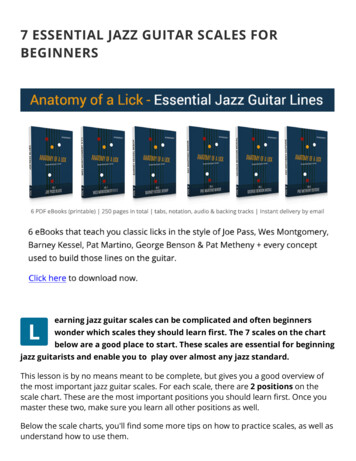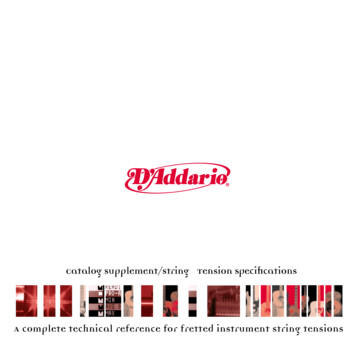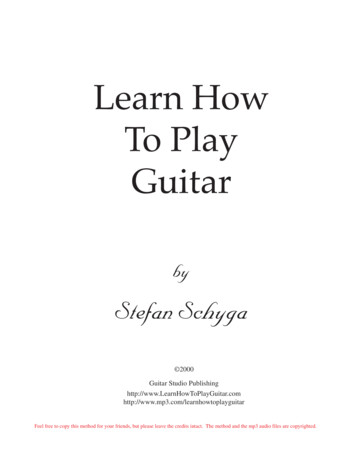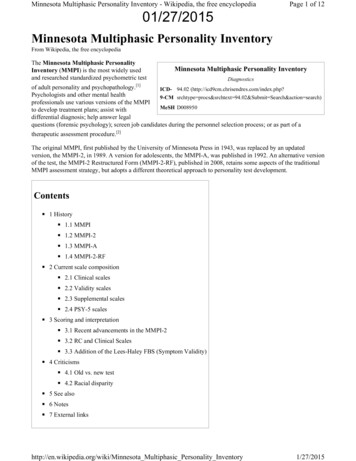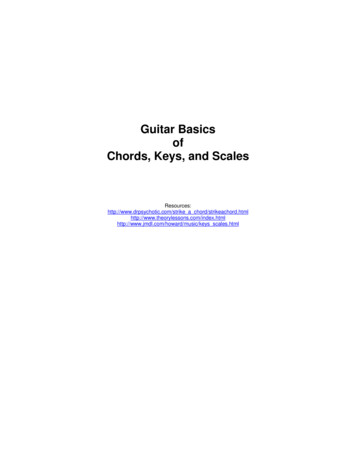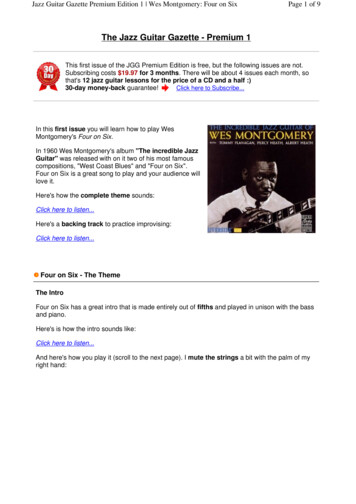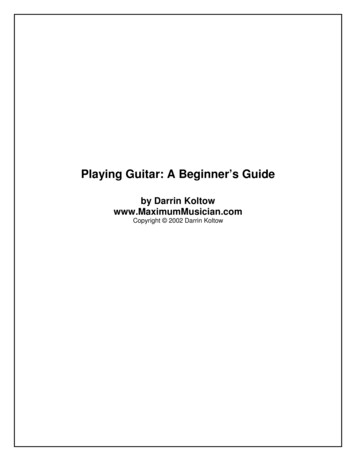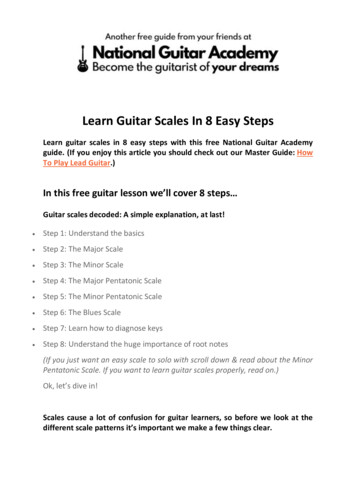
Transcription
Learn Guitar Scales In 8 Easy StepsLearn guitar scales in 8 easy steps with this free National Guitar Academyguide. (If you enjoy this article you should check out our Master Guide: HowTo Play Lead Guitar.)In this free guitar lesson we’ll cover 8 steps Guitar scales decoded: A simple explanation, at last! Step 1: Understand the basics Step 2: The Major Scale Step 3: The Minor Scale Step 4: The Major Pentatonic Scale Step 5: The Minor Pentatonic Scale Step 6: The Blues Scale Step 7: Learn how to diagnose keys Step 8: Understand the huge importance of root notes(If you just want an easy scale to solo with scroll down & read about the MinorPentatonic Scale. If you want to learn guitar scales properly, read on.)Ok, let’s dive in!.Scales cause a lot of confusion for guitar learners, so before we look at thedifferent scale patterns it’s important we make a few things clear.
Why is it important to learn guitar scales?Scales are the foundation of all lead guitar work and make it easy for you tocrank out awesome single-note melodies.When people start to learn guitar scales they unwittingly cross a ‘bridge’ andstart understanding music theory. This makes you a significantly betterguitarist because you start to truly understand the instrument.When should I learn guitar scales?It’s never too early or too late to learn guitar scales. They are beneficial toknow at any stage of your guitar journey.I prefer total beginners to focus on chords, but I would never discourageanyone who wanted to learn guitar scales from doing so. This is useful stuff.Ok, so what is a scale?A scale is a series of steps between two fixed musical points. These two fixedpoints are always the same note, but in different octaves. We call these points“root notes”.How we get from the lower root note to the higher root note is called ‘ascale’.
.Because there are 12 ‘rungs’ (AKA ‘notes’) there are lots of different patternsand permutations that we can choose to combine them in.I often see people trying to learn guitar scales get overwhelmed by the amountof patterns, but thankfully it’s very simple.There are only a couple of scale patterns that 99% of guitarists need to knowand we’re going to run through them here.Can you read chord & scale diagrams?To understand what’s coming next you need to be able to read chord diagrams(AKA ‘chordboxes’).If you can’t do this yet read this article: How To Read Chordboxes In 60SecondsAll of the scale diagrams in this guide follow this layout:
Ok, you came here to learn guitar scales so let’s look at our first scale!The Major ScaleIt is essential to understand how the major scale works because its pattern isthe yardstick by which we describe any other musical sound.Every chord and scale is named by how it compares to this scale. If you want tolearn guitar scales this is the best starting point.This is a bright and happy sounding scale. It’s uplifting, sweet and optimistic.Box 1 of the major scale looks like this (we’ll talk about ‘boxes’ later on):Did you spot the three root notes here? Well done! Like most other scaleboxes, this one covers TWO OCTAVES.Scales are moveable patternsA crucial point you must know if you want to learn guitar scales is that scalepatterns are MOVEABLE.What dictates the tonality of the scale is where you BEGIN playing it.If you start playing the above pattern on the 5th fret (so the root note on theleft is on the 5th fret of the 6th string) you will be playing the A Major Scale.If you play the same pattern from a starting position two frets higher (startingon the 7th fret) you will be playing the B Major Scale.
.A scale’s root note is the hero note. Use it lots.In every scale there is a root note. The root note is what names the scale. Inthe A Minor Pentatonic Scale the root note is A.In the E Major Scale the root note is E.The root note is the hero note. It’s the note that will sound best and give asense of resolution to the riffs, licks and solos that you play. Finish yourphrases on the root note to make what you played sound ‘right’.The Minor ScaleThe other scale that you must know if you want to learn guitar scales isthe Minor Scale.There are three different types of minor scale: The Natural Minor Scale (it is essential that you know this scale) The Harmonic Minor Scale (this is a cool scale and it would be good if youlearn this, but it’s not essential) The Melodic Minor Scale (it’s not essential that you learn this scale)
When people talk about “the minor scale” they are almost always referring tothe Natural Minor Scale. That’s the ‘main’ version of these three minor scales.The Minor Scale is much cooler than the Major ScaleThe Natural Minor Scale provides a counterpoint to the Major Scale. If youwant to learn guitar scales you need to understand the mood they create. Thisscale sounds sad and melancholy and the contrast from the Major Scale isstark.But of course, we need both! (Yin and Yang. Light and dark. Batman and theJoker, etc !)I think the Natural Minor Scale is much cooler than the Major Scale, it soundsmore interesting and evocative.But perhaps best of all, it gives us the foundation for the Minor PentatonicScaleand Blues Scale which are the most fun scales for the majority ofguitarists. (We’ll cover both of these scales later on in this guide.)Clearly, I’m not alone in liking the Natural Minor Scale because this scaleprovides the foundation for almost all rock and blues lead guitar. (Playing asolo in a minor scale over major chords just sounds awesome. I’ve been doingit for years and it gets more and more fun as time goes by!)The Natural Minor Scale looks like this:
Technically, this scale ‘ends’ on the root note at the right, but people tend toadd on the two notes on the far right. (These notes are from the start ofthe nextoctave.) I use all of these notes because they all sound good.The Harmonic Minor ScaleThis is only a little bit different to the Natural Minor Scale. Here wesharpen the penultimate note to make the pull back to the root note stronger.This creates an exotic sounding 3-step interval. Try it!Top tip: When soloing you can blend these two minor scales together and playa ‘hybrid’ scale like this:
.The Melodic Minor ScaleIn more traditional forms of music that 3-step interval isn’t welcome. So weadd an extra note to smooth the ascension. This creates the ‘melodic minorscale’. (AKA Jazz Melodic Minor Scale.) It looks like this:
Unless you want to learn jazz this is a pretty niche scale. Most guitarists won’tneed to know it.Major and Minor Pentatonic ScalesSo far we’ve covered the two pillars of music scale theory: the Major Scale andthe Minor Scale.These two scales are fundamental and you need to be aware of them, butmost intermediate guitarists play these two scales in a simpler and abridgedform.The Major Pentatonic Scale is the Major Scale in abridged form.So instead of playing the full major scale pattern like this:The Major Scale
We play a simpler version, like this:The Major Pentatonic ScaleCan you see that we simply removed two notes from each octave? (4 notes intotal.)I often see guitar learners make the mistake of thinking the Major Scale is atotally different scale to the Major Pentatonic Scale. No, the Major PentatonicScale IS the Major Scale, just in a simpler form.Similarly, the Minor Pentatonic Scale is the Minor Scale in abridged form.So instead of playing this:The Natural Minor Scale
We play this:The Minor Pentatonic ScaleCan you see how all we’ve done here is remove two notes from each octave?(4 notes removed in total.)So if you learn how to play the Major Scale and the Minor Scale you already‘know’ how to play their pentatonic versions. You just need to get accustomedto leaving those two notes out in each octave.Box 1 of the Major Pentatonic Scale looks like this:This isn’t the easiest scale to solo with, so the vast majority of intermediateguitarists use box 1 of the Minor Pentatonic Scale for the majority of their leadguitar work.
If you take only one thing away from this lesson it should be to learn thispattern:Minor Pentatonic Scale (Box 1)The Minor Pentatonic Scale is the best scale to learn if you want to learn guitarscales to play solos and lead guitar.In a moment we’ll look at one of the coolest scales of all, the Blues Scale.Before we do, let’s have a quick chat about ‘boxes’. (If you want to learn guitarscales you need to know this.).
A quick note on ‘boxes’The guitar neck is long and the notes overlap from one string to the next.There is no way we can memorise all the patterns in one go. To make life easier for ourselves we divide all scales on the neck into 5segments to make things more manageable. You can play every scale in each segment. We call these segments ‘boxes’.For example, with no boxes, this is what the full neck diagram looks like forthe E Minor Pentatonic Scale. This is overwhelming! So we do what we always do. We simplify. We break this long pattern into 5 shorter patterns. These 5 smaller patternsare called ‘boxes’.So for each scale, we have box 1, box 2, box 3, box 4 and box 5. (After the 12thfret, the 5 box patterns repeat again.)As you can see, the boxes overlap. The right side of box 1 is the left side of box2. And so on. From a music theory point of view, the notes in all 5 boxes follow the samemusical pattern. They are the same scale. But when these notes are laid out across the guitar fretboard the fives boxeslook very different from one another. They all share the same musical ‘DNA’, but their appearance is different.
That means we have to learn multiple patterns to play the same scale indifferent positions on the guitar neck.Don’t worry about learning boxes 2, 3, 4 and 5 right now. Just focus on box 1for each scale.Master box 1 of each scale before attempting othersIn this article, to keep things simple, we’ve just used box 1 for each scale. Thisis how you should approach this too.This is by far the best way to learn guitar scales. Just learn box 1’s for now, butknow that there are 4 more boxes for every scale. You can move onto these inthe future!Ok let’s look at my favourite scale of all, the Blues Scale. This is why we learnguitar scales!
The Blues ScaleThe Blues Scale is a very close relative of the Minor Pentatonic Scale. It soundsawesome in most rock, indie, country and blues scenarios.It looks like this:The Blues ScaleOne of the coolest things about the Blues Scale is that you can often play itover both major and minor keys.It won’t work over every chord progression, but it does work over lots. It’s aversatile scale.If you’re trying to learn guitar scales this is a huge boost, because it makeseverything easier.
KeysIf you want to learn guitar scales because you intend to play lead guitar youneed to know this:The easiest way to play lead guitar that will sound “good” is to play notes froma scale that matches the song’s key.This is so important I’m going to re-type it!!The easiest way to play lead guitar that will sound “good” is to play notes froma scale that matches the song’s key.So if the key of a song is C Major, you will sound awesome if you play a riff orsolo with notes from the C Major Scale. In this example, the key and the scalematch. Voila! We have harmony.How to work out the key of a songThe easiest way to work this out is to look at the first and last chord of thesong. (They’re often the same chord.) 99% of the time the key of the song willbe one of those two chords.A key-finding exampleSo for example, let’s say the first chord of the song is A minor.This means that you can play any note from the A Minor Scale (or the A MinorPentatonic Scale) and it will sound good. Some notes will sound better thanothers, but none of them will sound ‘bad’.Let’s look at another exampleLet’s say the first chord of the song was E major. You could play any note fromthe E Major Scale (or the E Major Pentatonic Scale) and it would sound good.Depending on the track, you may also be able to play the E Minor Scale, orthe E Minor Pentatonic Scale too. If it’s a rock track, the E Blues Scale mightalso work.NINJA TIP: You can often play a minor scale over a major key. This will oftensound good. This does not work as well the other way around! Try it and you’llHEAR the difference.
How to practice scalesWhen we learn guitar scales the first thing we need to do is commit the scalepattern to memory. The easiest way to do this is to break the scale into bite-sized chunks. So first ofall, focus only on box 1 for the scale. The notes of all boxes cover two octaves. So we can make things even easier byjust focussing on the first octave of box 1.So the easiest way to learn guitar scales is to ‘split’ the scale boxes into octaves1 and 2.An example of how to learn a guitar scaleLet’s use the G Major Scale as an example. Box 1 looks like this:
To begin with, focus on learning the first octave. This is the distance from thefirst to the second root note. In this box, for this scale, the first octavespans strings 6, 5 and 4:After you’ve memorised this, move onto the second octave, whichspans strings 4 to 1:Important point: Note that the last note of octave 1 is also the first note ofoctave 2. There are 8 notes in each octave, but there are not 16 notes in totalacross two octaves. There are only 15.
Why learn this way?To learn guitar scales we have to break things into bite-size chunks. It justmakes things faster.This octave-splitting method might not seem necessary for box 1 of easypatterns like the Minor Pentatonic Scale, but for more complicatedscales/boxes with more elaborate patterns this approach can make things a lotmore manageable and allow us to learn guitar scales quickly and more reliably.Here’s an important piece of techniqueRemember to use one finger per fret, like this:It’s ok to use the pads (the fingerprints) to play notes when you play leadguitar.This is something that should be avoided at all costs when playing chords, butwhen we’re trying to learn guitar scales it’s ok to adapt our fretting technique.In fact, it’s flat out beneficial!Learn slowly and correctly to embed good muscle memoryWhen we learn guitar scales it’s very important to learn slowly ANDcorrectly. You must resist the urge to play fast. Playing slowly and correctly isthe best way to embed muscle memory. Playing quickly leads to mistakes,frustration and twitchy muscle memory. That’s not what we want.
Practice ascending and descending the scales, but also try doubling back onyourself in different amounts. For example: ascend two notes, then descend one, ascend two, then descendone (and so on). Then try ascending 3 and descending one.These are useful ways to learn the scales rote, but of course let’s not lose sightof the final aim here which is to develop a sense of musicality.Nothing will improve your ability to learn guitar scales and play lead guitarmore than jamming.It is essential that you play the scales over MUSIC.Don’t become the classic bedroom guitarist. The type of people who simplylearn guitar scales and patterns in isolation. No!You need to develop a feel for these patterns. Play the scales over backingtracks (YouTube is filled with them) and reach out and connect with othermusicians who live locally to you.Playing with other musicians is transformative for your progress as a guitarist.Jam exercise – Try this backing trackHit play on the backing track below and play jam with some notes from the EMinor Pentatonic Scale:
Popular LessonsHow To Learn Guitar: An 11-Step Programme For Beginners10 Easy Songs For BeginnersHow To Strum A GuitarHow To Choose The Perfect Beginner GuitarGuitar Notes Explained: A Guide For BeginnersHow To Play Lead Guitar3 Easy Ways To Play BmMore Cool Guitar StuffLearn about the National Guitar Academy: About UsJoin us on Facebook for daily guitar tips.Listen to our Learn Guitar Podcast for rapid guitar progress.Check out our free chord lessons.
The Blues Scale The Blues Scale is a very close relative of the Minor Pentatonic Scale. It sounds awesome in most rock, indie, country and blues scenarios. It looks like this: The Blues Scale One of the coolest things about the Blues Scale is that you can often play it o
